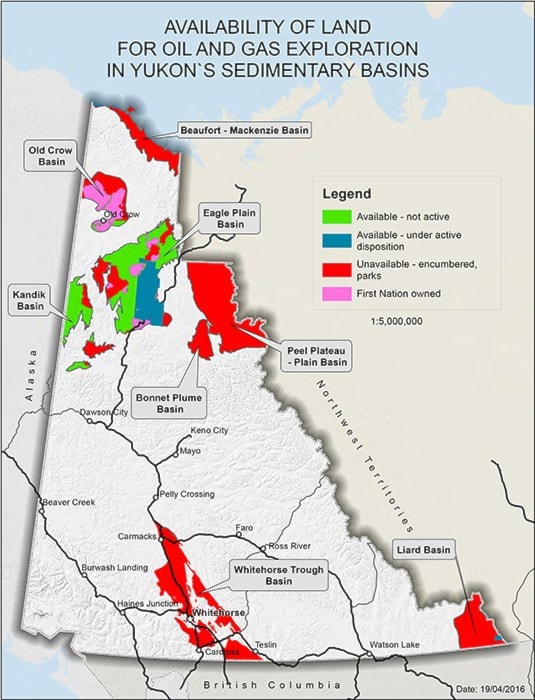For the first time in decades, there is interest in oil-and-gas development in Yukon’s remote Kandik basin.
A total of 13 posting requests for land parcels in the Kandik basin, as well as two new requests in the Eagle Plain basin, have been submitted to the Department of Energy, Mines and Resources for review.
The Kandik basin straddles the Yukon-Alaska border northwest of Dawson City, and extends east toward the western boundary of the Eagle Plain basin.
A resource assessment published in 2000 estimated there could be 54 million cubic metres of oil and 38 billion cubic metres of gas in the basin, but limited exploration drilling in the 1970s never located any reserves. Since then, no company has expressed interest in the region.
“It is, by and large, unexplored,” said John Fox, assistant deputy minister of Energy, Mines and Resources.
The 15 posting requests were submitted last fall. Fox wouldn’t confirm whether one or multiple companies are behind the requests, but he referred at one point to “the company,” suggesting there is only one.
All 15 parcels lie within the traditional territories of the Vuntut Gwitchin and Tr’ondek Hwech’in First Nations. Fox said the department has reached out to the First Nations to discuss the posting requests, but hasn’t yet met with them.
“It’s critically important with the new government and their efforts to work collaboratively with First Nations that this is a first step,” he said.
William Josie, Vuntut Gwitchin’s director of natural resources, told the News that Energy, Mines and Resources Minister Ranj Pillai has committed to visit Old Crow to “meaningfully consult” the First Nation about the parcels. He declined to say more before speaking with the minister. The Tr’ondek Hwech’in First Nation did not respond to a request for comment.
After the First Nation consultation, the requests will go out for public review. Some of the parcels could be rejected before that stage, depending on the discussions with affected First Nations.
The public review will last 60 days. The government will then decide which of the parcels, if any, should be included in a call for bids.
Any company can then submit a bid, though it must commit to a minimum of $400,000 worth of work per parcel. The highest bidder will receive an exploration permit.
However, any call for bids will specify that hydraulic fracturing is not permitted, Fox said. The new Liberal government was elected on a promise to impose a moratorium on fracking in the territory.
The fact that requests have been made doesn’t necessarily mean that exploration work will proceed. In 2012, for instance, 12 requests were submitted for the Whitehorse Trough, only to see the Yukon government declare the region off-limits to drilling.
Posting requests can be submitted to the government twice a year, in the spring and fall. Prior to last fall’s requests, there had been none since the spring of 2013. There haven’t been this many requests since the spring of 2007.
Fox wouldn’t speculate on what’s driving the interest in the Kandik basin now, but said it may be a long-term play, looking ahead to a time when “oil prices and gas prices would be at a level that would support potential production of anything that might be discovered.”
“Clearly the company has taken the time and effort to submit postings, so they obviously have a plan,” he said.
But the requests come as a surprise to Sebastian Jones of the Yukon Conservation Society, who said it’s “ridiculous” to think the Kandik basin parcels could ever be developed.
He pointed out that the region is remote, without road access. “To get to (the parcels) would require long roads over country that is incredibly untouched and opening up massive swaths of the country.”
Jones also pointed out that four of the parcels fall within the Dawson planning region, where land-use planning was put on pause in 2014 until the Peel watershed debacle is resolved.
“I’m astonished that they would consider oil proposals in an area that doesn’t have land-use planning,” said Jones. “It’s baffling to me.”
Fox said the fact that some of the parcels are in the Dawson planning region explains why consultation with First Nations is critical.
The other 11 parcels lie within the North Yukon planning region, where a land-use plan has been completed. Fox said they fall within the region zoned for “the highest level of land-use development.”
Contact Maura Forrest at maura.forrest@yukon-news.com
